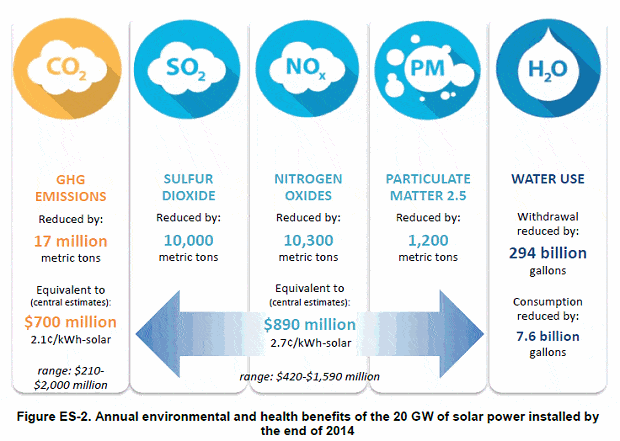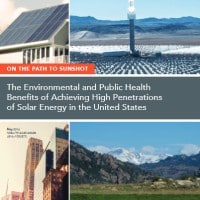A report from Lawrence Berkeley National Laboratory and the National Renewable Energy Laboratory (NREL) shows the American government’s solar energy goals could reap the national economy $400 billion just in environmental and health benefits by 2050 if projected solar uptake is achieved.
“We find that a U.S. electric system in which solar plays a major role—supplying 14% of demand in 2030, and 27% in 2050—would result in enduring environmental and health benefits,” said Ryan Wiser of Berkeley Lab’s Energy Technologies Area.
“Moreover, we find that the existing fleet of solar plants is already offering a down-payment towards those benefits, and that there are sizable regional differences in the benefits.”
The report, “The Environmental and Public Health Benefits of Achieving High Penetrations of Solar Energy in the United States” (PDF), forms part of the Energy Department’s On the Path to SunShot study, which provides an update on the progress of the nation’s ambitious program to make solar energy cost competitive with other forms of electricity by 2020.
Whereas the latest study centres on the SunShot program’s progress in building and maintaining a rich and prosperous solar sector in the U.S., the new report focuses on the financial benefits of reduced greenhouse gas emissions, air pollution-related diseases and water usage under high-penetration solar forecasts.

A previous SunShot Vision Study, published in 2012, found that should Sunshot meet its target of lowering the installed price of solar power by 75 percent between 2010 and 2020, solar could supply 14 percent of U.S. electricity demand by 2030 and 27 percent by 2050.
According to Lawrence Berkeley lab, the total monetary value of this high-penetration solar scenario exceeds $400 billion.
As at 2014, 20 GW of solar capacity was installed across the U.S., cutting annual GHG emissions by 17 million tonnes and reducing air pollutants from power plants.
Compared to a scenario of no new solar, the study reveals that successfully reaching the SunShot target would result in a drop in annual GHGs of 13 percent in 2030 and 18 percent in 2050 – reductions worth nearly $260 billion in avoided climate damage.
By curbing the generation of toxic emissions from power plants, including sulphur, nitrogen and particulates, SunShot would deliver a further $167 billion in health benefits and reduce infant mortalities from sulphate particles by up to 59,000, according to EPA estimates.
Under SunShot, water use by power plants would fall by 8 percent in 2030 and 5 percent in 2050, while water consumption is reduced by 10 percent in 2030 and 16 percent in 2050.
Under President Obama’s “social cost of carbon” estimate – the figure applied to the long-term damage caused by one tonne of carbon emissions – the USA’s existing fleet of solar plants and installations already save Americans more than $1.5 billion per year.












































